
Focus Question: What were the origins and consequences of anticommunism and McCarthyism?
Topics on the Page
Anticommunism and the Second Red Scare
- Margaret Chase Smith and the Declaration of Conscience Speech
People
Whittaker Chambers
Alger Hiss
J. Edgar Hoover
Senator Joseph McCarthy
Julius and Ethel Rosenberg
Senator Margaret Chase Smith
Institutions
American Communist Party (including its close relationship to the Soviet Union)
Federal Bureau of Investigation (FBI)
House Committee on Un-American Activities (HUAC)
 Dramatic Event Page: The Lavender Scare
Dramatic Event Page: The Lavender Scare
History of Civil Rights and the Red Scares
- The Palmer Raids
- The Scottsboro Boys
- McCarthyism and African Americans
Red Scare Propaganda Images
 Influential Literature Pages
Influential Literature Pages
 Cross-Link: AP U.S. HIstory Key Concept 8.1: The US and the Cold War
Cross-Link: AP U.S. HIstory Key Concept 8.1: The US and the Cold War
|
PAGE SUMMARY
This page describes anticommunist sentiment in the 1950s, which is known as the Second Red Scare. This was the widespread fear that anyone could be a communist.
This began when Senator Joseph McCarthy began publicly accusing people of being a communist. This led to the term McCarthyism. People who were accused of being a communist could face jail-time or could lose their jobs. People could be accused of being a communist even if they were not one.
Many members of the LGBTQ+ community, Black leaders, and other racial equality advocates were targeted. This page also describes several important historical figures relating to this topic, like Whittaker Chambers, Alger Hiss, J. Edgar Hoover, and Julius and Ethel Rosenberg. The page also details many institutions that are relevant to this topic, like the American Communist Party, the Federal Bureau of Investigation, and the House Un-American Activities Committee, and describes the responses to and criticisms of the Second Red Scare.
The page includes Margaret Chase Smith's Declaration of Conscience Speech.
(Jenna Boyer, April 2022)
|
The Second Red Scare
- This was the idea that everyday people were afraid that they knew someone who was a communist. People began accusing even their neighbors of being communist. In order to protect themselves, folks would often accuse others of being Communist so as to avoid suspicion.
- Communism was a large threat to people, and people were debilitated by the fear of spies
- This started with Senator Joe McCarthy, and the term McCarthyism was coined. He was a senator who started accusing everyone he knew of being a communist.
- If you were thought to be a communist you risked losing employment, housing, and were often thrown in jail. There was not always hard evidence to support that an individual was a communist. Any person with socialist ideals or ways of thinking as well as revolutionary/reformative groups like folks involved in the Civil Rights Movement.
- Minority groups were also often the focus of persecution. This includes BIPOC and members of the LGBTQIA+ community specifically.
- This is a game I found that can be played where everyone gets assigned a position, and it shows the classroom that people turned against everyone they knew because of this fear, and at the end it has a small worksheet review about the game and the thoughts upon the game.
 Learning Plans
Learning Plans
Lesson Plan: Anticommunism in Postwar America 1945-1952
Anticommunism in the 1950's, from the Gilder Lehrman Institute of America.
 Click here for a learning plan involving an activity with puzzles about the Second Red Scare.
Click here for a learning plan involving an activity with puzzles about the Second Red Scare.
- This learning plan involves groups of students trying to complete a puzzle with an imposter in the group trying to sabotage them. In the second round, there is no imposter.
- This is supposed to represent McCarthyism and the suspicion and fear that everyone around you was a communist during this time period
Red Scare Dot Activity
This activity shows students the hysteria that was present during the Red Scare.
 Click here for an interactive, online review game about McCarthyism and the Second Red Scare.
Click here for an interactive, online review game about McCarthyism and the Second Red Scare.
How You Can Fight Communism: An article by James F. O'Neil that appeared in a 1948 edition of the American Legion magazine.
Read about the Red Scare
 Ted Ed video describing the origins of anticommunism and McCarthyism.
Ted Ed video describing the origins of anticommunism and McCarthyism.
- Immigrants feared that they would be targeted during the Red Scare.
Short article about the targeting of immigrants during the 1919's-1920'sFor a fascinating history of American communism, the Red Scare, and McCarthyism, read The
Legacy of McCarthyism, edited by Ellen Schrecker.

Margaret Chase Smith's Declaration of Conscience Speech
On June 1st, 1950, Smith delivered a speech on the Senate floor that lasted nearly four hours which condemned in unequivocal terms Joseph McCarthy’s anti-communist statements which falsely accused members of the government of being Communists.
 Senator Margaret Chase Smith's response to Joseph McCarthy, A Declaration of Conscience, given June 1, 1950.
Senator Margaret Chase Smith's response to Joseph McCarthy, A Declaration of Conscience, given June 1, 1950.
- In that speech, she said: “ I don’t want to see the Republican Party ride to political victory on the four horsemen of calumny—fear, ignorance, bigotry and smear.”
- She was the only woman member of the Senate at the time.
- Smith was the first woman elected to both the House and the Senate.
- She ran for President in 1964
Follow this link for an article on the role of Jewish women in the rise of the American Communist Party.
 Listen to the Speech here
Listen to the Speech here
View Bridget Bleakley deliver the speech at National Oratory 2018 at Ford's Theatre
.png) Executive Order 10450 (April 27, 1953)
Executive Order 10450 (April 27, 1953)
- President Eisenhower Prohibits Lesbian and Gay Federal Workers. The policy was changed by the Civil Service Commission in 1975.
Click here to watch a video about the Lavender Scare.
Click here for a timeline from Seattle Civil Rights and Labor History Project.
PEOPLE
Whittaker Chambers
Whittaker Chambers was a writer who also was a member of the communist party. He was a US citizen but he was also a spy for the Soviet Government. He would testify in the Alger Hiss trial of 1948.
"Letter to my Children" By Whittaker Chambers from the forward to Witness
Alger Hiss
Alger Hiss was a US citizen and involved in the US government accused of being a communist. He would be one of the first people to be tried by HUAC (House Un-American Activities Committee).
HUAC was lead by a young Richard Nixon. Hiss was tried in 1948 and convicted of perjury in 1950 though he claimed he was innocent.His conviction intensified the Red Scare.
Alger Hiss Trials
J. Edgar Hoover Official Portrait, 1953
J. Edgar Hoover

J. Edgar Hoover was the head of the FBI from 1924 to 1972. During his time there he sought tougher guidelines and penalties for those found to be involved in organized crime or the Nazi or Communist parties. He also used his power as FBI director to maintain secret records on American citizens who were engaged in peaceful protests against existing policies. This is an interview with Hoover which follows his (however distorted) view on the FBI's tactics involving The Red Scare.
Click here for a link to FBI files on Eleanor Roosevelt.
Click here for FBI files on Cesar Chavez and the United Farm Workers.
 Click here for background information on the FBI files for poet Allan Ginsburg and historian Howard Zinn.
Click here for background information on the FBI files for poet Allan Ginsburg and historian Howard Zinn.
Joseph McCarthy and Roy Cohn, 1954
 Senator Joseph McCarthy
Senator Joseph McCarthy
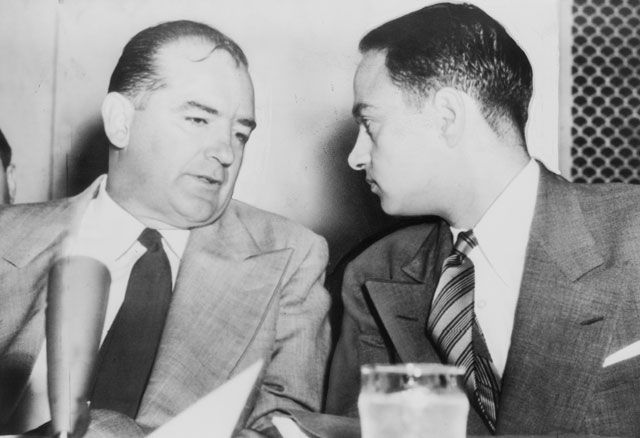
Sen. McCarthy was the leading voice in the "Red Scare" of the Cold War.
- He accused many people of being communists or communist spies. He scared his audiences by waving around what was often a blank sheet of paper claiming he had a long list of known communists working in the state department.
- He was censored by the senate in 1954 and died in 1957 while still in office.
Julius and Ethel Rosenberg, after being found guilty, 1951

Julius and Ethel Rosenberg
They were a husband and wife team who worked with atomic weapons development during WWII. They were accused of being spies, tried in 1950, convicted in 1951 and executed in 1953. They were the first spies to be killed for their actions.
.png) The Rosenberg Trial--Was Justice Fairly Served?
The Rosenberg Trial--Was Justice Fairly Served?
.png) Here is a selection of letters written between Ethel and Julius Rosenberg while in prison.
Here is a selection of letters written between Ethel and Julius Rosenberg while in prison.
Ayn Rand testified in front of HUAC in 1947. Read her transcript.
Institutions
American Communist Party was founded in 1919 in Chicago.
Soviet and American Communist Parties, Library of Congress
Communist Party USA, from The Strange Career of Jim Crow website
Moscow's Archives and the New History of the Communist Party of the United States, American Historical Association (2000)
Federal Bureau of Investigation (FBI) was founded in 1908.
-
Its purpose was to investigate crime in the US on the federal level.
-
The Bureau was founded by Charles J. Bonaparte who was the Attorney General of the United States at the time.
-
The FBI was later recognized by Attorney General Harlan Fiske Stone in 1924 who appointed J. Edgar Hoover as its first director.
- Under Hoover's direction, the FBI issued a national "Most Wanted List" for known fugitives and criminals in the United States (1932), established a technical lab which was used to test and analyze fingerprints, handwriting, firearms, and other data for the purpose of forensic analysis of criminal investigations (1932), and founded an academy used to train special agents (1935).
- Originally called The Bureau of Investigation, it was renamed The Federal Bureau of Investigation in 1935 under Hoover. During the McCarthy years the FBI was used to investigate persons of interest who were believed to be Communist or sympathetic to the Communist Party.
View more information on the history of the FBI.
The History of the FBI's Secret Enemies List, NPR (February 14, 2012)
View a prezi of the history and establishment of the FBI.
HUAC ( House Un-American Activities Committee)
This was a committee set up to investigate communist activity and any other types of activity which were deemed Un-American. HUAC would hold their questioning in front of Congress. This was considered controversial, as it intimidated many of their witnesses. Their actions contributed to the fear and panic of the Cold War Era. In 1969, it was renamed as the Committee on Internal Security. Several celebrities of the time were even investigated. Click here for more info.
The HUAC launched an investigation into Hollywood, suspecting actors, screenwriters, and directors of communist tendencies.
.png) In 1952, Supreme Court Justice William O. Douglas commented on the Red Scare and published an essay known as "The Black Silence of Fear."
In 1952, Supreme Court Justice William O. Douglas commented on the Red Scare and published an essay known as "The Black Silence of Fear."
The Trials of J. Robert Oppenheimer
Albert Einstein and J. Robert Oppenheimer

Life of Robert Oppenheimer video
If you are interested in combining material concerning the Manhattan Project and the Second Red Scare, American Experience on PBS produced a wonderful documentary chronicling "The Trials of J. Robert Oppenheimer".
After his successful scientific leadership of the Manhattan Project, he later faced criticism concerning his past political associations.
As a result, the federal government revoked his security clearance in 1954.
Cross-link Wiki Page: The Manhattan Project and the Atomic Bomb
| Draft Reply by President Truman (probably not sent) to Joseph McCarthy, 1950 |

History of Civil Rights and the Red Scare
- Attorney General A. Mitchell Palmer depicted America’s own tiny radical fringe as a serious revolutionary threat (based on Russia’s Bolshevik Revolution)
- He unleashed the Bureau of Investigation (FBI) against suspected Socialists, Communists, anarchists, and unionists
- Countless homegrown radicals were deported or arrested in order to suppress left-wing thinking
- Peaceful members expelled
- Many states outlawed “criminal syndicalism” which was a catchall offense that made advocacy of revolution illegal and rendered any expression of radicalism, however innocuous, vulnerable to prosecution
- Blacks escaped the dragnet because they were American citizens but the Justice Department treated black militancy as subversion (anybody who opposed white supremacy ran the risk of being targeted as a dangerous radical)
- Bolshevism was an easy explanation for black unrest and a quick excuse for anti-Black violence
- Justified lynchings and race riots as patriotism
The Red Summer of 1919 was a season in which intense race riots broke out. These riots were caused by the prominent and atrocious violence by white supremacists on Black people in the united states. It is important to understand the anti-communism movement in relationship with white supremacy. Click this link and answer the multiple schoice question to the best of your ability. READ the ANSWER and EXPLANATION fully.
Communist Influence in Civil Rights Organizations in the 1930s and the Scottsboro Boys Trial

- For more on the International Labor Defense and Communist influence in Civil Rights Organizations, read Chapter 7 of Better Day Coming by Adam Fairclough
The Red Scare/McCarthyism
- McCarthyism became the term for hysterical anticommunism (after Republican Senator Joseph McCarthy)
- Communism became paramount to treason (prosecuted and jailed)
- Victims of government repression were Communists, the Communist Party, Communist controlled unions, and Communist front organizations like the Civil Rights Congress
- Individuals who refused to denounce Communism and name names faced being fired, blacklisted, prosecuted, and deported
- Blacks distrusted anti-Communists as Communists had sharpened their fight for equal rights
- Many anti-Communists were also racist
- There was a fear that if the rights of Communists were abridged, their own rights would be further curtailed
- NAACP was convinced to take an anti-Communist resolution in order to survive (however, did great damage to the organization)
- The government and states often forced organizations (like the NAACP) to give up lists of their members
- This caused many members to leave the organizations for fear of being targeted as a Communist
- Being charged as a Communist could mean being the victim of a violent or deadly attack, being arrested, and/or losing your economic security
- W.E.B. Du Bois was arrested in 1951 at the age of 82 for being an agent of foreign power and confiscated his passport even when the charges were dropped
- 1958 got his passport back when the Supreme Court ruled the tactic was illegal, joined the Communist party, and left for Ghana
- Paul Robeson (singer) criticized the US and praised the Soviet Union and got his passport taken away/travel to Canada prohibited
- Vigilantes attacked his concerts and his music career ended
- Government said his problems would disappear if he abandoned his outspoken stand against racism and colonialism, he refused
- White defenders of segregation used the charge of Communism to attack anyone supporting racial equality
- The government used the FBI to ascertain the exact extent of the Communist threat
- Virtually every black American organization and leader was suspected by the FBI
- Brenda Gayle Plummer concluded that the FBI was less interested in deterring subversion than in discrediting blacks ‘deemed too independent, unconventional, or influential’
.png) Red Scare Propaganda Images
Red Scare Propaganda Images
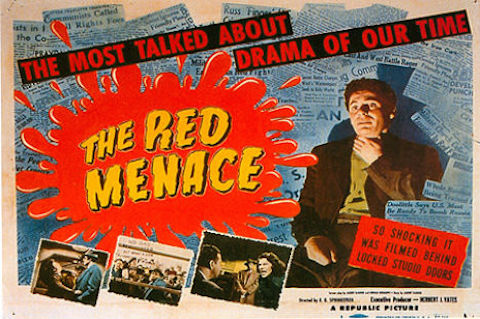
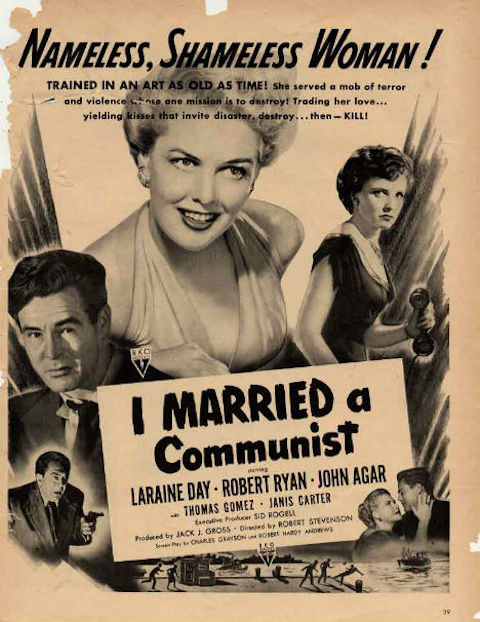
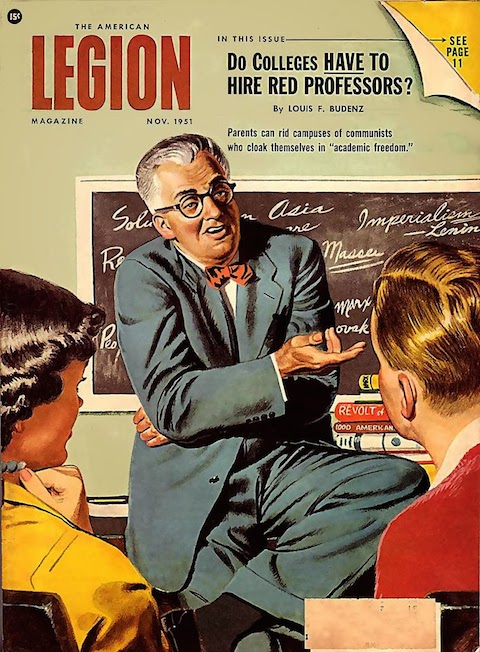
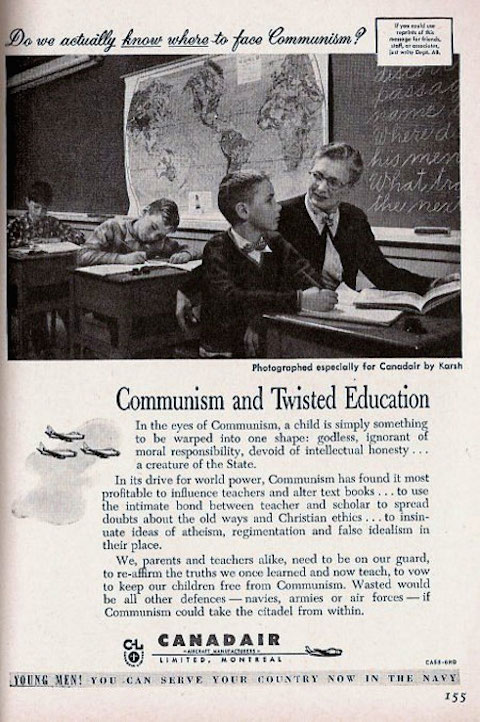
Comments (0)
You don't have permission to comment on this page.